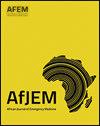无声的流行病:探讨索马里一家三级医院急诊科爆炸和枪伤的临床流行病学影响
IF 1.2
4区 医学
Q3 EMERGENCY MEDICINE
引用次数: 0
摘要
背景爆炸和枪伤等大规模伤亡事件对公共卫生构成重大挑战。本研究分析了索马里爆炸伤和GSWs患者的临床流行病学概况和结果。方法对2021年1月至12月索马里一家三级医院急诊科收治的225例患者进行回顾性分析。收集的数据包括损伤类型、解剖分布、人口统计学、住院情况和结果。结果225例爆炸伤和GSW伤中,爆炸伤占58%,GSW伤占42%。绝大多数患者为男性(85.3%),其中GSW组89.5%,爆炸组82.3%。超过一半(58.7%)的患者年龄在18 ~ 30岁之间,其中爆炸组59.2%,GSW组57.9%。解剖分析显示,与GSW患者相比,头部损伤最常见(21%),特别是爆炸病例,头部(26.2%)、颌面(7.7%)和下肢损伤(12.3%)的发生率更高。21.7%的患者从急诊科出院,19%的患者进入ICU,住院死亡率为12.9%,其中3例(1.3%)患者死于急诊科,均来自爆炸伤组。结论创伤性损伤发生率的上升需要采取多方面的措施,包括加强应急响应系统和公共卫生倡议。这些数据呼吁医疗保健提供者和决策者采取行动,优先考虑索马里爆炸和枪击相关伤害的管理和预防。本文章由计算机程序翻译,如有差异,请以英文原文为准。
A silent epidemic: Exploring the clinico-epidemiological impact of explosion and gunshot injuries in the emergency department of a tertiary hospital in Somalia
Background
Mass casualty incidents, such as explosions and gunshot wounds (GSWs), pose significant public health challenges. This study analyzes the clinico-epidemiological profile and outcomes of patients with explosive injuries and GSWs in Somalia.
Method
A retrospective analysis was conducted on 225 patients admitted to the Emergency Department of a tertiary hospital in Somalia between January and December 2021. Data collected included injury type, anatomical distribution, demographics, hospital admissions, and outcomes.
Results
Of the 225 explosion and GSW injuries, explosive injuries accounted for 58 %, while GSWs made up 42 %. The majority of patients were male (85.3 %), with 89.5 % in the GSW group and 82.3 % in the explosion group. More than half(58.7 %) of the patients were aged 18 to 30 years, with 59.2 % in the explosion group and 57.9 % in the GSW group. Anatomical analysis revealed that head injuries were most common(21 %), particularly in explosion cases, as well as higher rates of head (26.2 %), maxillofacial(7.7 %), and lower-limb injuries (12.3 %) compared to GSW patients. Some 21.7 % of patients were discharged from ED, 19 % admitted to ICU and an inpatient death rate of 12.9 %, including three patients (1.3 %) who died in the Emergency Department, all from the explosion injury group.
Conclusion
The rising incidence of traumatic injuries necessitates a multifaceted approach, including enhanced emergency response systems and public health initiatives. This data serves as a call to action for healthcare providers and policymakers to prioritize the management and prevention of explosion and gunshot-related injuries in Somalia.
求助全文
通过发布文献求助,成功后即可免费获取论文全文。
去求助
来源期刊

African Journal of Emergency Medicine
EMERGENCY MEDICINE-
CiteScore
2.40
自引率
7.70%
发文量
78
审稿时长
85 days
 求助内容:
求助内容: 应助结果提醒方式:
应助结果提醒方式:


